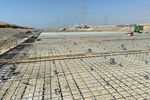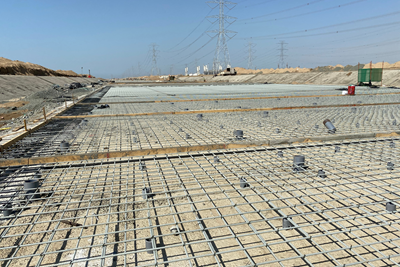University of Miami faculty explore ways to improve resilience of coastal structures
Engineering and ocean sciences faculty members receive federal research funding to delve into how they can strengthen coastal buildings and seawalls in the face of climate change through new materials and better-designed structures.
(From left): Assistant professor of engineering, Landolf Rhode-Barbarigos, along with associate professor of practice, Esber Andiroglu and assistant professor, Prannoy Suraneni, display some of their coastal resilience research project at the eMerge Americas conference in April. Photo Credit: Mike Montero/University of Miami
Faculty members from Florida-based University of Miami’s College of Engineering and Rosenstiel School of Marine and Atmospheric Science were recently awarded a pair of grants from the National Institute of Standards and Technology (NIST, Gaithersburg, Md., U.S.), a division of the U.S. Department of Commerce, to explore novel ways to fortify structures that border the U.S. coastline. This includes exploration of innovative materials like fiber-reinforced concrete.
The two grants — which amount to nearly $800,000 over three years — are part of a larger $7.6 million investment by the National Science Foundation and NIST to support research that expands on the nation’s knowledge of community and infrastructure resilience to hurricanes, wildfires and other natural hazards.
The awards came just months after the creation of the University’s Climate Resilience Academy, launched in spring 2022 to incite more collaboration between faculty, industry and government to find innovative remedies to issues related to the climate crisis, sustainability and resilience.
“Of just eight grants awarded by NIST for this disaster resilience research, two came to the University of Miami,” Jeffrey Duerk, executive vice president for academic affairs and provost, says. “This is a testament to our faculty members’ commitment to finding solutions that will help sustain our community in the face of climate change.”
One of the two principal researchers is Prannoy Suraneni, assistant professor of engineering, who is leading a team to investigate how innovative building materials like ultra-high-performance concrete and glass fiber-reinforced polymers can help make seawalls better equipped to withstand erosion and cracking from seawater, waves and storm surge.
Suraneni, an expert in cement chemistry, is looking forward to testing the performance of glass fiber-reinforced, ultra-high-performance concrete. His team will also be evaluating the ability of these materials to create more sustainable seawalls, which could prove useful in coastal communities.
In addition, for the second grant, engineering assistant professor Landolf Rhode-Barbarigos is working with ocean sciences professor Brian Haus at the Rosenstiel School to quantify the coupled action of hurricane wind, storm surge and waves on structures in coastal locations like Miami.
“Ultimately, our hope for these projects is to change the way engineers think about designing structures, not just for strength but also for resilience,” Suraneni says. “We also hope that this research will change the way people choose materials in the building industry.”
Both Rhode-Barbarigos and Suraneni have been engaged in coastal resilience research for the past four years with the University’s Laboratory for Integrative Knowledge (U-LINK), a program that offers seed funding to interdisciplinary faculty teams to investigate complex societal problems, such as climate change. Ideally, these teams can garner external funding to expand and continue their research, which is one goal of the U-LINK program. Rhode-Barbarigos and Suraneni consider the NIST projects an extension of work done with previous U-LINK teams.
"I’ve been studying seawalls and other coastal defenses as part of U-LINK grants, and the university’s support significantly helped us strengthen our application for the NIST funding,” Suraneni adds.
As part of the NIST projects, both teams will be doing physical testing in the Alfred C. Glassell Jr. SUSTAIN laboratory at the Rosenstiel School, along with testing in other university labs and field testing. At the SUSTAIN facility, Suraneni and Rhode-Barbarigos will be able to simulate hurricane conditions to test the performance of new materials and measure the forces they would be up against in a strong tropical storm or hurricane.
This will be especially critical for Rhode-Barbarigos’ project, which hopes to make buildings along the coast less vulnerable with the possibility of more intense hurricanes and tropical storms on the horizon. Currently, engineers design structures using separate load models for wind, waves and storm surge that they later combine, Rhode-Barbarigos points out. However, during a storm, wind, waves and storm surge are always linked. Therefore, as part of this research, he wants to create new load models for structural engineers that account for combined action of wind, storm surge and waves.
Suraneni, an expert in cement chemistry, is looking forward to testing the performance of glass fiber-reinforced, ultra-high-performance concrete. This is an alternative to the traditional steel-reinforced concrete, but one that aims to avoid corrosion that often causes concrete structures in saltwater environments to degrade. His team will also be evaluating the ability of these materials to create more sustainable seawalls, which could prove useful in coastal communities. The team includes Rhode-Barbarigos; Antonio Nanni, professor and chair of the Department of Civil and Architectural Engineering; Esber Andiroglu, engineering associate professor of practice; and Haus, a physical oceanographer and coastal engineer who directs the SUSTAIN facility.
“These projects will be important for a lot of applications in the field, where you can use these new loads to revamp building codes. Or in the case of the materials, they could be used to improve coastal construction,” Haus says. He leads the university’s Department of Ocean Sciences and is a co-investigator on both projects.
Related Content
The state of recycled carbon fiber
As the need for carbon fiber rises, can recycling fill the gap?
Read MoreCFRTP enables better, greener smartphones
Carbon Mobile’s “monocoque” design eliminates separate case, cover and frame, better protects electronics and simplifies disassembly.
Read MoreComposite rebar for future infrastructure
GFRP eliminates risk of corrosion and increases durability fourfold for reinforced concrete that meets future demands as traffic, urbanization and extreme weather increase.
Read MoreMaterials & Processes: Resin matrices for composites
The matrix binds the fiber reinforcement, gives the composite component its shape and determines its surface quality. A composite matrix may be a polymer, ceramic, metal or carbon. Here’s a guide to selection.
Read MoreRead Next
Composite rebar for future infrastructure
GFRP eliminates risk of corrosion and increases durability fourfold for reinforced concrete that meets future demands as traffic, urbanization and extreme weather increase.
Read MoreComposite rebar for future infrastructure
GFRP eliminates risk of corrosion and increases durability fourfold for reinforced concrete that meets future demands as traffic, urbanization and extreme weather increase.
Read MoreCW’s 2024 Top Shops survey offers new approach to benchmarking
Respondents that complete the survey by April 30, 2024, have the chance to be recognized as an honoree.
Read More











.jpg;maxWidth=300;quality=90)













